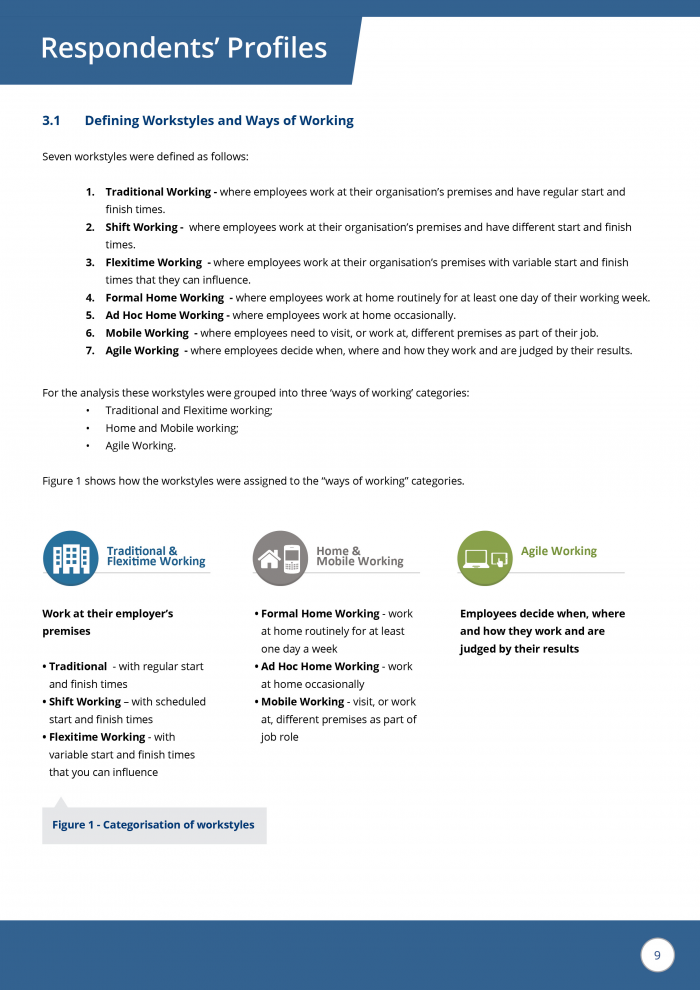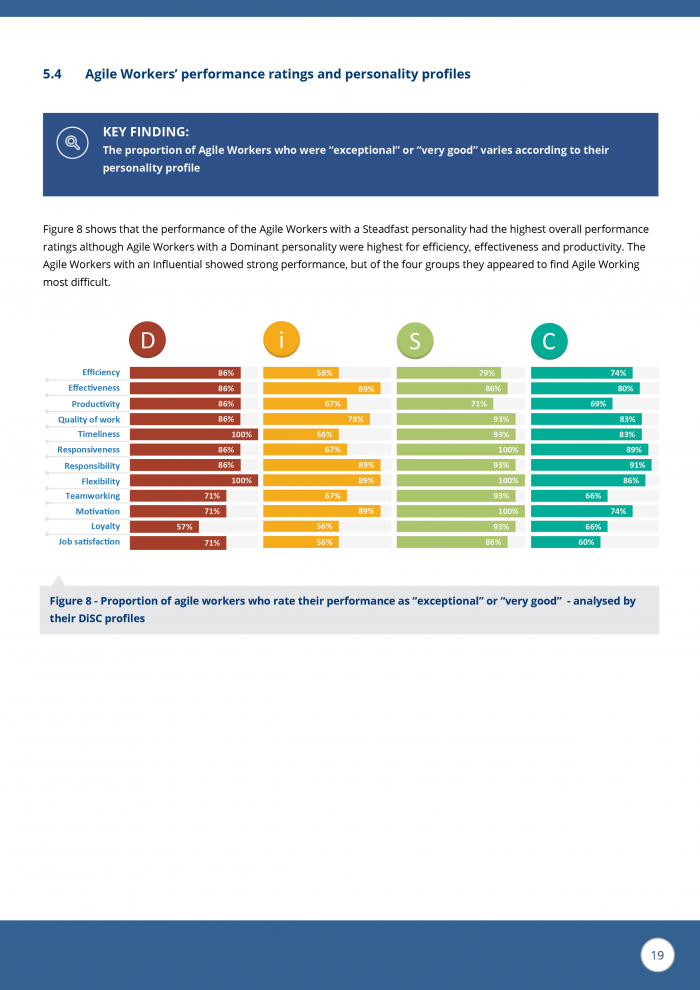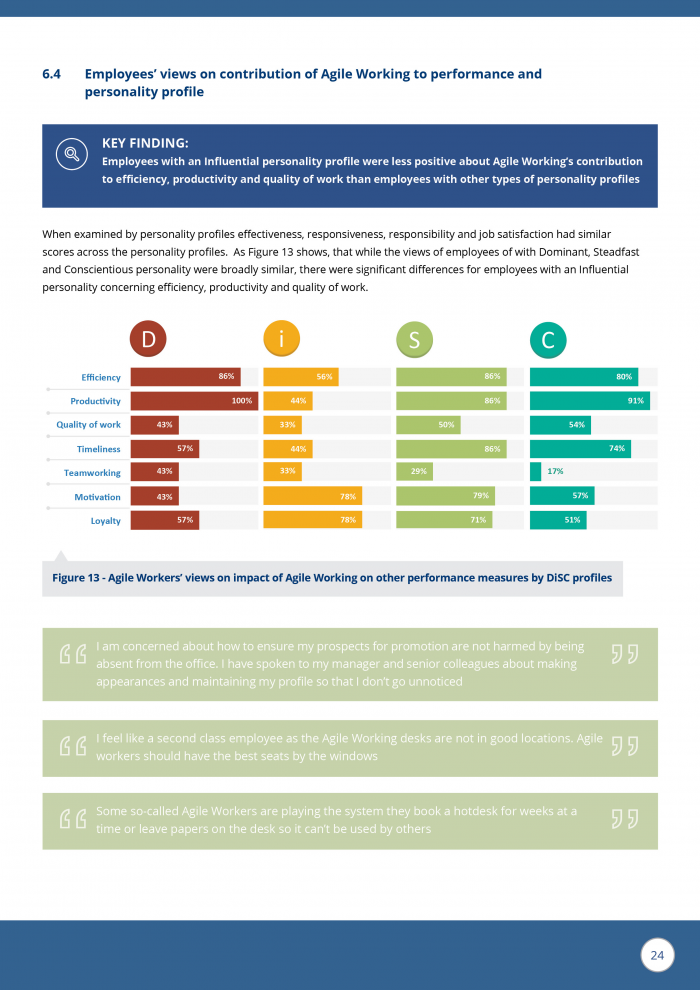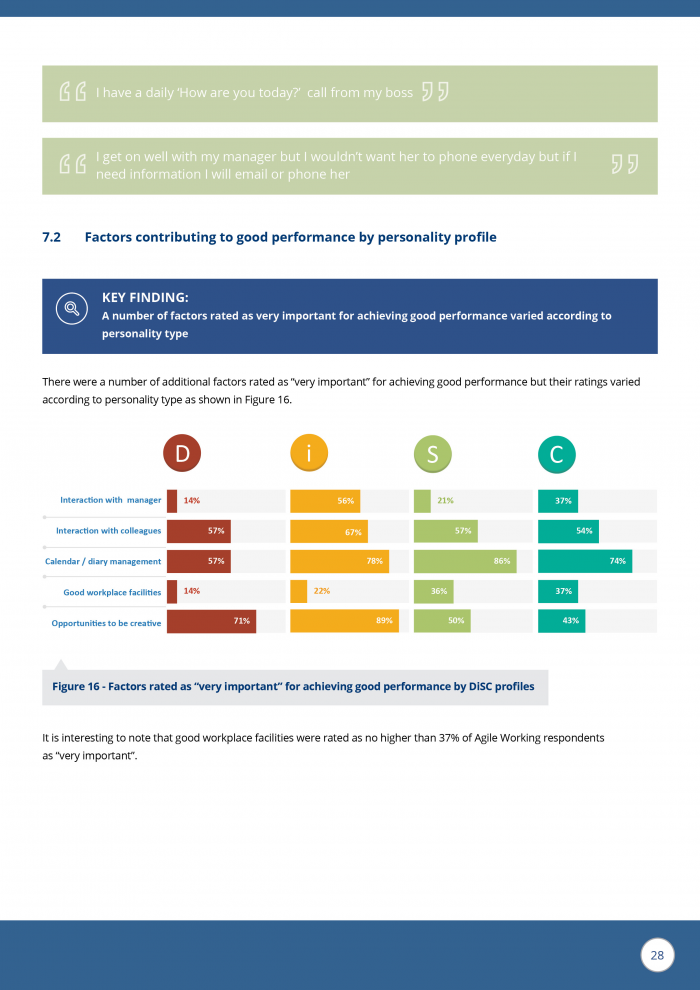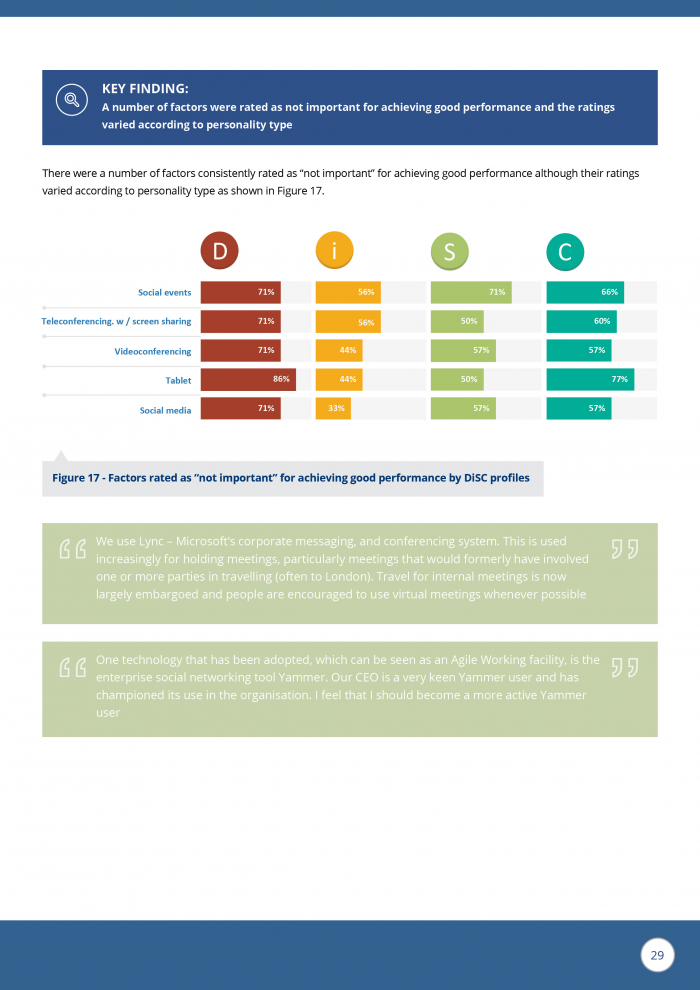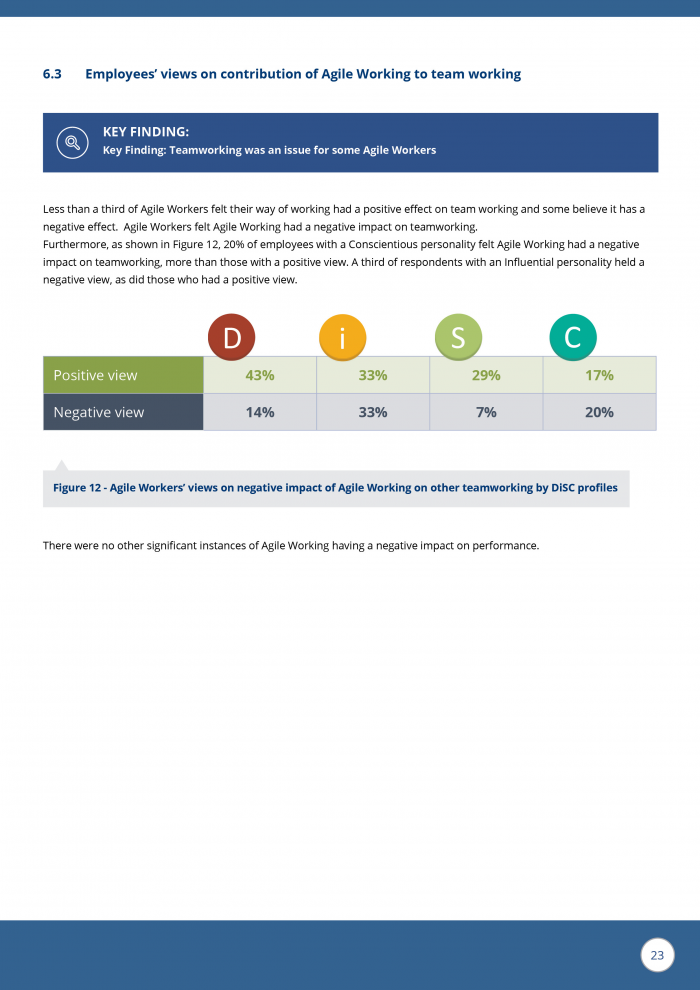November 15, 2017
The contribution of personality to the performance of agile workers
The introduction of agile working into organisations has typically focussed on the workstyles of different job roles, but has tended to treat the jobholders within these groups in the same way. The successful introduction of new ways of working clearly relies on the willingness of the people occupying the job roles to embrace new ways of working; yet there has been little investigation of the needs of agile workers with different personality types beyond looking at the needs of extroverts and introverts. These studies have tended to focus on the workplace; for example, the Cushman Wakefield Workplace Programme briefing paper examines how organisations can accommodate the needs of extroverts and introverts working together in the workplace. However, using OCEAN personality profiles, Nigel Oseland found that different personality types have different preferences, which in turn are likely to affect their performance at work.
This new research looked at the links between agile working, personality and performance to see if different people are more suited to different ways of working and if organisations should use different approaches to agile working employees to increase their productivity. The research, undertaken by JEC Professional Services, was commissioned by the Employers Network for Equality and Inclusion (enei), with sponsorship from DWF and Santander,
The research looked at four main personality types and found differences, as well as commonalities, in both their performance and their attitude to agile working. Those with an Influential personality profile appeared to have the most challenges, particularly with team working, although this is also an issue across a number of personality types. While all participants valued reliable technology there was little interest in more sophisticated technology tools and only a small proportion rated a good workplace as very important. In general there were no significant differences between respondents based on age, gender, job role, length in job role or employment status.
Methodology
584 employees and managers from Birmingham City Council, DWF (a major business law firm), Santander, the?Department for Work and Pensions, the Ministry of Justice and the NHS chose to participate in the survey. All had some autonomy in where, when, and how they chose to work. Each participant was asked to:
- Complete an Employees’ Ways of Working Questionnaire to describe the way they work and their views on performance and workstyles.
- Send a request to their line manager asking them to complete a Manager’s Questionnaire to provide a confidential view about the employees’ performance in relation to their way of working.
- Complete a Personality Profile Questionnaire.
A literature search was undertaken of published papers on ways of working and personality and performance.
Figure 1 shows how different workstyles were assigned to ways of working categories.
Figure 1 – Assignment of workstyles to ways of working categories
Personality types
To provide the personality assessments we used the DiSC® profiling technique, which takes its name from the initials of its four main factors:
- Dominance (D)
- Influence (I)
- Steadfastness (S)
- Conscientiousness (C)
DiSC is a well-proven test used by some 41 million people across 50 countries since 1984. By looking at the relationships between different factors, it is possible to build up a library of individual traits that a person possesses and also assess traits that a person lacks. Employees with a high score on each of the DiSC personality traits can be summarised as follows (the proportions in the sample are shown in brackets they add up to more than 100 percent because an individual can score high on several different traits):
- Dominant (10 percent) – are “doers” and “go getters” who like to get things done and quickly. They are driven to achieve.
- Influential (14 percent) – thrive within a team environment where there is lots of human interaction. They like freedom but are not disciplined.
- Steadfast (26 percent) – like structure and routine with a stable workload. They are strong team players who will put the needs of others in front of their own.
- Conscientious (61 percent) – have little desire for human and social interaction. They like to work on their own. They enjoy spending time on detail.
The sample contained a larger proportion of respondents with Conscientious personalities than would be expected. This may be the result of those with a Conscientious personality being more willing to complete a voluntary survey or a high representation in the sample populations.
Performance and personality profile
Employees from different “ways of working” categories were asked to rate their performance across a range of performance measures. The employees’ line managers were also asked to assess the performance their staff, to provide a different perspective on the impact of ways of working on performance. In general, line managers’ responses validated their employees’ responses.
The proportion of agile workers who were rated “exceptional” or “very good” varied according to their personality profile. Figure 2 shows that the performance of the Agile workers with a Steadfast personality had the highest overall performance ratings, although Agile workers with a Dominant personality were highest for efficiency, effectiveness and productivity. The Agile workers with an Influential personality showed good performance, but of the four groups they appeared to find Agile Working most challenging.
Figure 2 – Proportion of Agile workers who rate their performance as “exceptional” or “very good” – analysed by their DiSC Profiles
Rating of Agile Working by different personality types
Agile workers’ were asked for their views on the positive impact of agile working on a number of performance measures. When examined by personality profiles: effectiveness, responsiveness, responsibility and job satisfaction all had similar scores. However, as Figure 3 shows; while the views of employees with Dominant, Steadfast and Conscientious personality were broadly similar, employees with an Influential personality profile were less positive about agile working’s contribution to efficiency, productivity and quality of work than employees with other types of personality profiles.
Figure 3 – Agile workers’ Views on the positive impact of Agile Working on other performance measures by DiSC Profiles
Factors contributing to Good Performance by Personality Profile
Factors rated as “very important” for achieving good performance by Agile workers across all personality types were communications, teleconferencing, smartphones, laptops, good remote access to systems and files, and fast reliable networks. There were a number of other factors where the ratings varied according to personality type as shown in Figure 4. Good workplace facilities were rated “very important” by less than 40 percent of respondents and particularly low by those employees with a Dominant personality; possibly reflecting the amount of work that now takes place away from an office. A study by Julian Thompson and Prof. Edward Truch suggests that the most direct benefit from flexible working comes from a perceived improvement in personal productivity. They attribute this to a less distracting, more conductive work environment away from an office environment.
As might be expected, “interaction with colleagues” was rated highest by those employees with an Influential personality who also rated the importance interaction with their manager significantly higher than the other personality types.
Figure 4 – Factors Rated as “very important” for achieving good performance
Perhaps most surprising were the factors rated as “not important” for achieving good performance with just some variations according to personality type as shown in Figure 5. Although teleconferencing was rated as “very important” by 51 percent across all types, more sophisticated technologies’ involving screen sharing and videoconferencing were deemed as “not important” by all groups, with the exception of employees with an Influential personality, who perhaps value the additional communications facilities that these technologies afford.
Nigel Oseland points out that 55 percent of communication is non-verbal, 38 percent done by tone of voice, and only 7 percent related to the words and content, clearly non-verbal communication is a key component of interaction. He argues that virtual collaboration systems therefore need to replicate this basic communication need, especially in the early stages of team forming or when the team consists of a high proportion of extroverts. Social communications, both physical (social events) and electronic (social media) were not valued by most employees although more so, not unexpectedly, by those with an Influential personality.
Figure 5 – Factors Rated as “not important” for achieving good performance by DiSC Profiles
Team working
Team working was a particular issue and the only example of where Agile Working had a negative impact on performance. Overall, less than a third of Agile workers felt their way of working had a positive effect on team working, with some believing it had a negative effect. Furthermore, as shown in Figure 6, 20 percent of employees with a Conscientious personality felt Agile Working had more of a negative impact on teamworking than those with a positive view. A third of respondents with an Influential personality held a negative view, but this was matched with those who had a positive view. Those with a Dominant personality had the most positive view of team working although arguably team working is not a priority for employees with this personality type.
Figure 6 – Agile workers’ views on negative impact of agile working on teamworking by DiSC profiles
Conclusions
This research indicates that it is important to consider the needs of the different personality types of employees when making the transition to an Agile Working environment. The DiSC profiles analysis provides guidance on how these employees should be managed.
- Managing Employees with a Dominant Personality. These employees can be a little maverick in their working approach, so managing them with an element of “boundary setting” is advisable. The best way to manage these individuals within an agile working environment is to give them an element of structure and objectives to achieve, with touch points during the working day/week to ensure they are not going off the path. These individuals will more than likely not be too bothered whether they have an agile or traditional working environment, as they are able to work in a variety of environments and do what needs to be done. However, an agile working environment may be beneficial for them as they can manage their own diaries and work hours that suit them, as long as they understand the job that must be done and which they are achieving.
- Managing Employees with an Influential Personality. These employees working in an Agile Working environment will need strong management and much more direction and expectation setting. As Agile Working allows individuals to take ownership of their working environment, it will need managers to have interaction with them every day. So a start up call and end of day call with these individuals is advisable.
- Managing Employees with a Steadfast Personality. These employees need to feel comfortable about agile working and that they are trusted. Regular contact and setting structure and deliverables will provide this. These individuals like to plan their day and will go out their way to ensure they achieve objectives as they don’t like to disappoint. Be aware when asking for feedback on how Steadfast individuals are adapting to an agile working environment, as they may be reluctant to give an honest answer for fear of upsetting their manager or the status quo.
- Managing Employees with a Conscientious Personality. These employees should be allowed to work to a high level of detail, but ensure they are not working very long hours and burning themselves out due to this autonomy. There needs to be interaction with colleagues, which should be encouraged through conference calls/video conferencing or other communication mediums to ensure that team interaction is not lost. A key point to be aware of is that these individuals are perfectionists, and may present more detailed work than is normally required, so setting out expectations will be key.
The survey has also indicated the need for organisations to address issues in teamworking in their implementation of agile working. Team working is clearly an important factor in performance but is difficult to get right. From the survey responses it appears that the implementation of Agile Working in a number of the participating organisations has not effectively addressed teamworking. Furthermore the survey suggests that social events and social media, or the way they were being used, were not regarded as relevant by the survey respondents.
Cushman Wakefield argues that, if organisations want to change how teams/departments gain synergy in collaboration, they must recognise the differing communication preferences in the workplace and provide an environment that meets employees’ needs and also provides a support platform for collaboration.
In summary, employers need to compensate for the reduction in face-to-face contact time which results from the adoption of agile working with effective communications, new team protocols and the appropriate use of conferencing technologies.
This feature was originally published in Work&Place Journal
__________________________________________________
 John Eary is a Director of JEC Professional Services, a consultancy with a strong track record in providing advice and support on Agile Working and exploiting IT effectively. John has assisted over 30 organisations adopt new ways of working. John is a regular blogger on agile working and seeks to provoke thinking on the opportunities and challenges for new ways of working presented by technology. John regards himself as a true agile worker practising work-life integration.
John Eary is a Director of JEC Professional Services, a consultancy with a strong track record in providing advice and support on Agile Working and exploiting IT effectively. John has assisted over 30 organisations adopt new ways of working. John is a regular blogger on agile working and seeks to provoke thinking on the opportunities and challenges for new ways of working presented by technology. John regards himself as a true agile worker practising work-life integration.
References
- Introverts vs. Extroverts (July 2013) – Do office environments support both? – Cushman & Wakefield
- Personality and Preferences for Interaction, (December 2013) – Nigel Oseland, Workplace Unlimited
- Research Report on Agile Working, Personality & Performance (2015) – John Eary, JEC Professional Services, enei
- Fast Forward 2030 – The Future of Work and the Workplace, (Oct 2014), Genesis Research Report
- The Flex Factor: Realising the value of flexible working, (July 2013) – Julian Thompson and Prof. Edward Truch, RSA
- The Psychology of Collaboration Space, (June 2012) Nigel Oseland, Workplace Unlimited





